what plants did christopher columbus bring to america
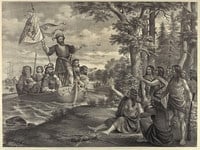
When Christopher Columbus first reached the Bahamian Islands in 1492, he encountered a native civilisation completely unfamiliar to Europeans. Native Bahamian foods were foreign and surprising to Columbus and his crew. Columbus and early colonizers adopted Bahamian foods, while simultaneously introducing European foods to the Americas. As ii vastly dissimilar cultures converged, a native population was all but destroyed, as a make new food culture developed.
During the 15thursday and 16th centuries, a number of European countries financed sailing expeditions in hopes of finding uncharted lands, gold and other riches. In the early 1400s, the Portuguese backed a successful expedition to Asia and Africa. When the ships returned with gold, spices, and slaves (incomprehensibly, humans of color were traded like a commodity), other countries joined in global exploration.
For the previous century, Spain had been occupied with political affairs concerning the Jewish and Muslim population. In 1492, Male monarch Ferdinand and Queen Isabella issued an edict (known as the Alhambra Prescript) decreeing that all Jews should be driven out of the kingdom. That same twelvemonth, a young Genoese man named Christopher Columbus (known in Spain as Cristóbal Colón) embarked on an exploratory voyage to the Far Eastward.
Interesting Side Note: It is now theorized that Christopher Columbus may accept in fact been a Jew living in hiding—known at the fourth dimension as a converso. Read more hither.
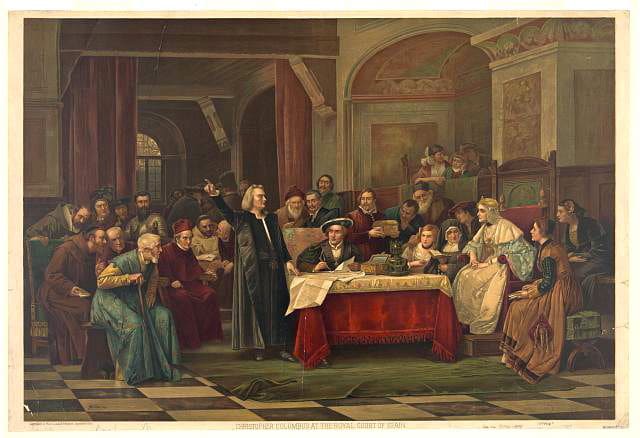
Christopher Columbus at the majestic court of Espana, presenting his asking to Queen Isabella I and Ferdinand V and a gathering of courtiers. Library of Congress.
Columbus, a self-taught scholar and voracious reader, had studied math, astronomy and cartography. He told the Spanish monarchs that he strongly believed he could accomplish Asia from Europe past sailing west beyond the Atlantic. After lobbying the Spanish court for two years, his trip was finally financed.
Columbus embarked on the first of what would be iv voyages, reaching the Bahamian Islands on October 12, 1492. He discovered a thriving indigenous people, the Taino (a tribe of the native Arawaks), who drew sustenance from colorful native crops, fish, and game. Maize, beans, squash, and seafood were central components of the native diet. In 1 of his logs, Columbus described a native meal, which was comprised of fish and "bread which tasted exactly every bit if it were made of chestnuts."
Fish and wild fowl (turkey) were the main sources of meat. Other regional crops included cacao (chocolate), maize, tater, lycopersicon esculentum, capsicum, peppers, cassava, pumpkins, and groundnuts (peanuts). Tropical fruits enhanced the native diet, such as pineapple, avocado, guava, and papaya. Most of these foods were new and unfamiliar to Columbus and his crew. In Hispaniola, the first settlement in the New World, the native foods of the Taino tribe became an important source of sustenance to the European colonizers.
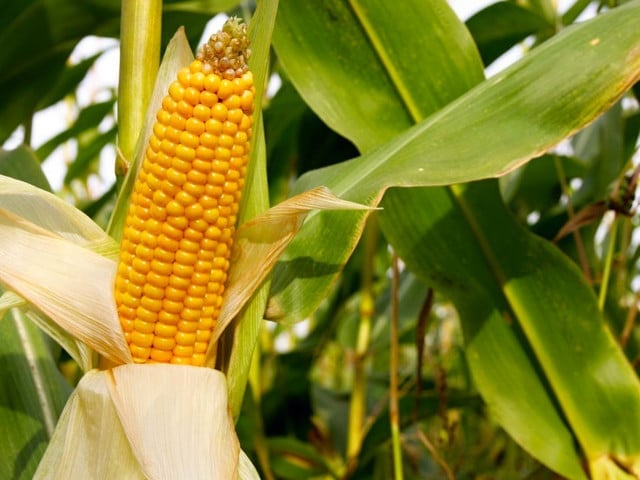
Maise was the principal native crop of the indigenous Taino tribe.
xtrekx/Depositphotos.com
In the early on days of Hispaniola, many European colonizers died due to disease. At the fourth dimension, their demise was largely attributed to malnutrition. While European settlers enjoyed native foods fabricated with maize and cassava, they believed that somehow their bodies were not equipped to handle these foods. On subsequent voyages to the New Earth, Columbus brought with him European foodstuffs that would drastically change the cultural and ecological landscape of the Americas.
While European colonizers had difficulty adjusting to the new food culture of the Americas, their arrival took an even greater toll on the native landscape. Earlier Columbus came to the New World, it is estimated that some 250,000 natives Arawaks lived on the Bahamian islands. By the early 1500's, less than 15,000 remained, most having perished afterwards exposure to European diseases (for which they had no amnesty).
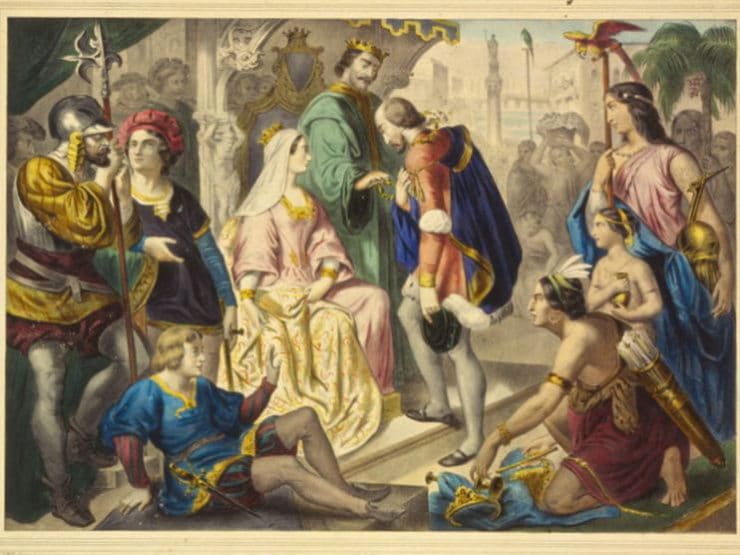
Retour de Christophe Colomb – Christopher Columbus being greeted by King Ferdinand and Queen Isabella on his return to Kingdom of spain. Vve. Turgis, éditeur. Library of Congress.
On Columbus' 2nd voyage he brought wheat bread, besides as radishes, chickpeas, and melons. Livestock came from Europe, including horses, cattle, pigs, sheep, goats, and chickens. Over fourth dimension, new crops were introduced to the Americas, including wheat, rice, barley, oats, coffee, sugar cane, citrus fruits, melons and Kentucky bluegrass.
The introduction of wheat was of particular significance. For thousands of years, bread had been a central part of the European diet. Wheat was non indigenous to the Americas, where maize was the native grain. In the first few decades of colonization, European settlers imported goods like bread, wine, olive oil and certain meats. Over time, wheat and other European foodstuffs were cultivated and grown in the Americas.
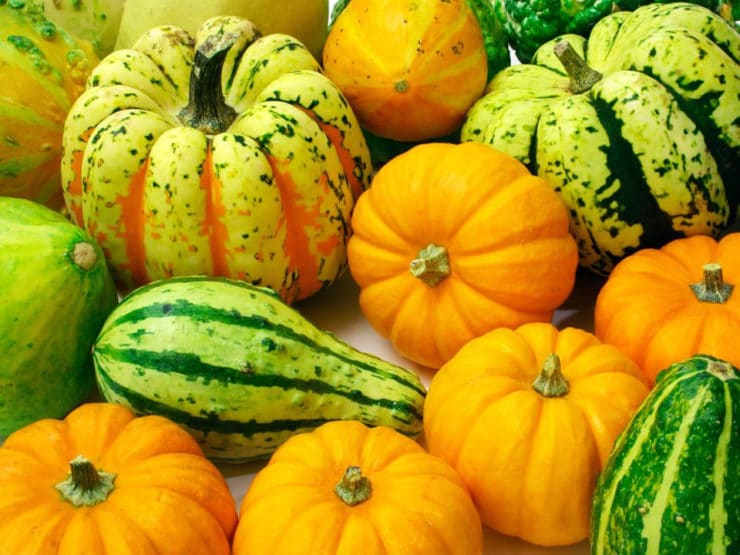
Sure native foods were considered "barbaric" by European settlers, only considering they were unfamiliar. Ironically, other foods were adopted readily, including chile peppers, cacao, and pineapple. Settlers enjoyed native foods like atole (a sugariness, hot drink made from masa), pinole (toasted maize meal), scalded plantains, butter of the cacao, and puddings made with fowl.
When all is said and done, the Spanish hoped to Europeanize the native populations of the islands of the Caribbean and catechumen them to Catholicism. By attributing the deaths of European settlers to native foods, they were buoying their argument for the superiority of European nutrient and, simultaneously, European values. The truth is, the arrival of European settlers devastated a thriving native population and landscape. This foreign and sad intersection of native American foods and European crops gave rising to a brand new nutrient culture.
Enquiry SOURCES
Andrews, Jean (1993). "Diffusion of MesoAmerican Food Complex to Southeastern Europe." Geographical Review, Vol. 83, No. 2 (April., 1993), pp. 194-204
Bergreen, Lawrence (2011). Columbus: The Four Voyages. Viking, New York, NY
Burkholder, Mark A. and Johnson, Lyman L. (2003). Colonial Latin America. Oxford University Press, 1994, 2nd ed., New York, NY
Columbus, Christopher and Cohen, J.1000. (Translator) (1992). The Four Voyages: Being His Own Log-Book, Letters and Dispatches with Connecting Narratives. Penguin Classics, New York, NY
Cook, David Noble (2002). "Sickness, Starvation and Death in Early on Hispaniola." The Periodical of Interdisciplinary History, Vol. 32 No. 3 pp. 349-386.
Divina, Fernando and Marlene (2004). Foods of the Americas: Native Recipes and Traditions. Ten Speed Press, Berkeley, CA
Earle, Rebecca (June 2010). "If You Eat Their Food… Diets and Bodies in Early Colonial Spanish America." American Historical Review, Vol. 115 No. three, pgs. 688-713. University of Chicago Printing, Chicago, IL.
Kiple, Kenneth F. (2007). A Moveable Feast: Ten Millennia of Food Globalization. Cambridge Academy Press, New York, NY.
Isle of man, Charles C. (2005). 1491: New Revelations of the Americas Before Columbus. Vintage Books, New York, NY.
Mann, Charles C. (2011). 1493: Uncovering the New World Columbus Created. Knopf, New York, NY.
Greogory McNamee. Movable Feasts: The History, Scientific discipline and Lore of Food. Westport, Ct.: Praeger, 2007.
Milioni, Stefano (1992). Columbus Bill of fare: Italian Cuisine Afterwards the Beginning Voyage of Christopher Columbus, 1492-1992. Italian Trade Commission, New York, NY.
Source: https://toriavey.com/history-kitchen/foods-of-the-new-world/
0 Response to "what plants did christopher columbus bring to america"
Post a Comment